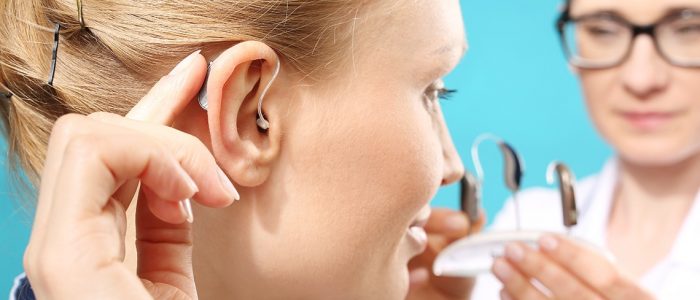What is a hearing aid and what are its benefits? How do these devices that amplify sound work? What are their types and what are the tips for choosing the right one?
A hearing aid is a small electronic device that is worn inside or behind the ear. People with hearing loss can hear, communicate, and participate more fully in daily activities by making some sounds louder. In other words, hearing aids help you hear more in quiet or noisy situations.
The basic parts of the hearing aid are three:
- Microphone
- Amplifier
- Speaker
The microphone receives the sound, and the hearing aid converts the sound waves into electrical signals that it sends to the amplifier. The amplifier increases the power of the signals and sends them to the ear through a speaker.
How a hearing aid helps me
The main use of hearing aids is found by those with damage to the small sensory cells of the inner ear (ciliates) to improve their hearing and speech understanding.
This type of hearing loss is known as sensorineural hearing loss. It is a damage that can be as much a consequence of a disease, as of aging, noise injury or reaction to certain medications.
Hearing aids are responsible for magnifying the sound vibrations that enter the ear. Surviving sharp cells can detect the largest vibrations and convert them into neural signals that are transmitted to the brain. If a person's hair cells are severely damaged, the more severe the hearing loss is, so further amplification will be needed.
However, there are some practical limitations to the amount of amplification that a hearing aid can provide. Hearing aids are ineffective when the inner ear is severely damaged and even large vibrations fail to turn into neural signals.
How to know if I need a hearing aid
Visit your doctor if you feel you have a hearing loss and think you might be in need of a hearing aid. A doctor can refer you to an otolaryngologist or audiologist:
- The otolaryngologist is the doctor who specializes in disorders of the ear, nose and throat. He will investigate the cause of the possible hearing loss.
- The audiologist is the hearing healthcare professional who can identify and measure hearing loss and who can perform a hearing test to assess the type and degree of loss.
What types of hearing aid styles are there?
There are five types of hearing aids: behind-the-ear (BTE), receiver-in-the-ear (RITE), in-the-ear (ITE), intracanal (ITC), and deep insertion intracanal (CIC).
The behind-the-ear hearing aids They consist of a hard plastic sleeve that is placed behind the ear and is connected to a plastic mold that is inserted inside the outer ear. The electronic parts are kept in the case at the back of the ear. Sound travels from the hearing aid through the earmold to the ear. Behind-the-ear hearing aids are used by people of all ages with mild to profound hearing loss.
There is a new open-fit BTE device that fits completely behind the ear, with only a narrow tube inserted into the ear canal, allowing the canal to remain open. Open-fit hearing aids can be a great option for people who experience earwax build-up, as these types of devices are less likely to be damaged by earwax. Also, some people may prefer this type of open-fit hearing aid because it prevents their voice from sounding "stuffy."
The in-ear hearing aids (ITE) it fits completely inside the outer ear and is used for mild to severe hearing loss. The hard plastic box that contains the electronic components may have certain additional functions installed, such as a telecoil. Instead of using a microphone, the telecoil is a small magnetic coil that helps the user to receive sound through the hearing aid. Among its advantages, it makes it easier to listen to conversations on the phone or in public facilities where special sound systems have been installed (induction loop systems), which can already be found in many churches, schools, airports and auditoriums. induction loop. This ITE model is not recommended for young children, as their housings must be replaced frequently as the ear grows.
The channel devices They fit into the ear canal and come in two styles, although both can be used for mild to moderately severe hearing loss. The hearing aid in the canal (ITC) is designed to fit the size and shape of the user's canal. Completely in the canal (CIC) hearing aids are almost hidden in the ear canal.
Channel devices can be difficult for one person to adjust and remove due to their small size. They have less space for batteries and additional devices, such as telecoils. Normally, its use is avoided in young children or people with severe to profound hearing loss because its small size limits its power and volume.
How a hearing aid works
A hearing aid works differently depending on the electronics used. Mainly, there are two types: analog and digital.
Analog hearing aids convert sound waves into electrical signals that are amplified. They are custom built for each user and programmed by the manufacturer to your audiologist's recommended specifications. This type of hearing aid has several programs or settings, which you can modify using a computer to change the program according to the listening environment in which you find yourself. These types of devices are usually more affordable than digital ones.
Digital hearing aids convert sound waves into numerical codes before amplifying them. The code includes information about the pitch or volume of a sound, so the device can be programmed to specifically amplify some frequencies more than others. Digital hearing aids can be programmed to focus on sounds coming from a specific direction.
How to know which hearing aid I need
The ideal hearing aid for you depends on the type and severity of your hearing loss. If you have hearing loss in both ears, typically two hearing aids are used to provide a more natural signal to the brain. Listening in both ears will also help you understand speech and locate the source of the sound.
Discuss with your audiologist which device best suits your needs, lifestyle, and price. However, avoid using price alone to determine which device is right for you. Remember that a more expensive hearing aid than another does not necessarily mean that it is better suited to your needs.
Hearing aids do not restore their wearer's normal hearing, but in practice they increase their knowledge of sounds and their sources, which can affect your quality of life and your your self-esteem level. Focus on making it convenient and easy to use, as you will be using it frequently. Among the other features you need to consider are:
- Parts or services covered by the warranty
- Estimated program
- Maintenance and repair costs
- Upgrade options and opportunities
- Hearing aid company's reputation for quality and customer service
How do I make sure I buy the right hearing aid?
Before purchasing your hearing aid, ask your audiologist to answer the following:
- What features does someone like me need?
- What is the total cost of the hearing aid? Are the benefits of new technologies greater than the higher costs?
- Is there a trial period to test the hearing aids? What fees are non-refundable if the grants are returned after the trial period? How long is the warranty? Can it be expanded? Does the warranty cover future maintenance and repairs?
- Can the audiologist make adjustments and provide minor services and repairs?
How do I adapt to my hearing aid?
You will need time and patience to use a hearing aid successfully. Try to use them regularly to adapt to them as soon as possible.
In a consultation with your audiologist practice putting on and taking off the device, cleaning it, identifying the right and left device, and replacing the batteries. Ask him to explain how to use it in listening environments where you have problems. Learn to adjust the volume and schedule for sounds that are too loud or too soft.
Work hand in hand with your audiologist until they feel comfortable and satisfied.



